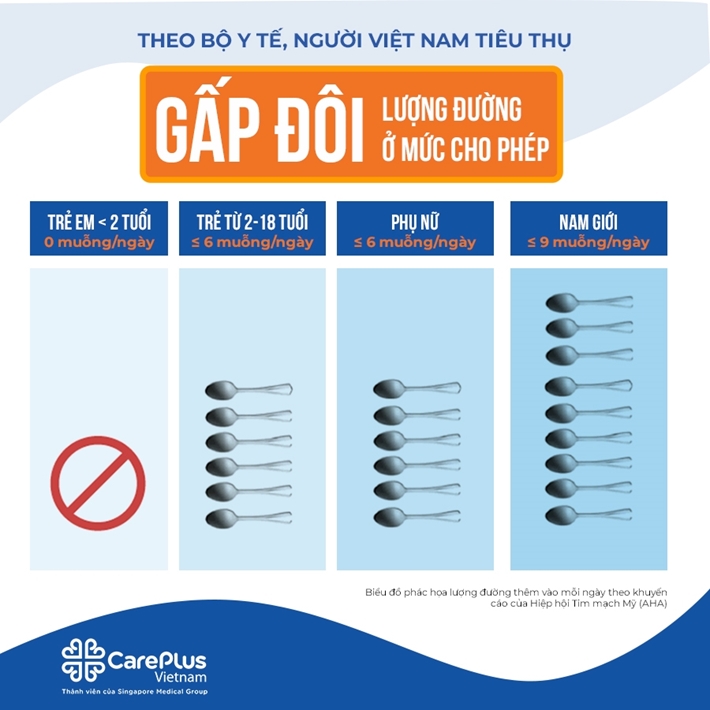Daily Intake Of Sugar
According to the Ministry of Health, on average, Vietnamese of all ages are consuming twice more added sugar than recommendations.

1/13/2021 1:52:46 PM
The American Heart Association recommends limiting added sugars to less than 9 teaspoons of added sugars per day recommendations based on age and gender. According to the Ministry of Health, on average, Vietnamese of all ages are consuming twice more added sugar than recommendations. Which leads to fat accumulation, metabolic disorders, overweight, obesity, osteoporosis, and especially causes cardiovascular diseases such as hypertension, stroke, cerebral embolism, etc.
Sugar hiding in plain sight
There are added sugars and natural sugars. Natural sugars are often found in fruits, vegetables, whole grains high in fiber and micronutrients. Not only sweet foods like confectionery, yogurt contain added sugar but also ketchup, pasta sauce, soy milk, sports drinks, grilled skewers or peanut butter is hidden sugar.
But how is sugar hiding?
Can't you just look on food labels? It's not that easy. We don't mean five or six, try fifty-six. There's brown rice syrup, barley malt, demerara, Florida Crystals, muscovado, and, of course, high fructose corn syrup, sometimes called HFCS, or corn sugar. Therefore, the sugar content might appear to be okay, but in the reality, sugar can be the single biggest ingredient.
What Does Sugar Actually Do To Your Body?
Sugar is the main energy for the physical body. But how’re the differences between glucose and fructose?
Glucose provides energy for nearly all organisms. It is found in starchy foods like rice, corn, potatoes, pumpkins, cereals, and nuts. However, your glycemic index will increase if you absorb too many carbs from biscuits, white bread, and bad starch.
Fructose, also known as fruit sugar, provides energy mainly to the liver. Due to its high fiber, eating plenty of fresh fruit will not overload with fructose. In contrast, the fructose in drinks, cakes, soda easily increases fat, causes non-alcoholic fatty liver and high - cholesterol leading to cardiovascular disease.
Enough sugar for a great wellness
American Heart Association (AHA) says that the maximum amount of added sugar per day for men is 150 calories (about 37.5 g or 9 teaspoons of sugar), for women 100 calories. (about 25g or 6 teaspoons of sugar). Accordingly, daily food can calculate the conventional sugar equivalent as follows:
- 1 cup of rice contains about 45-50g of carbohydrates
- 1 sweet potato about 160g contains 45g of carbohydrates
- 1 teaspoon of granulated sugar contains 4 grams of sugar
- 1 tablespoon of granulated sugar contains 6 grams of sugar
- Soft drinks (including canned fruit juices, lemon soda, bottled lemon tea, carbonated soft drinks) all contain 10-14g of sugar per 100g of product. Energy drinks more, up to 19g sugar / 100g of product. Thus, with just a 330ml can of soft drink (containing about 34g of sugar), your body has consumed a high amount of sugar compared to the permitted level in one day.
- In particular, sugary milk contains about 6-10g of sugar / 100g of product (the highest amount of sugar is in chocolate-flavored milk). Yogurt also contains about 10g / 100g of product. Therefore, although milk is a recommended food, if you use it regularly, your body will consume a fairly high amount of sugar.
Simply choosing water over soda, juices, and sports drinks is a great way to avoid hidden added sugar. At the very least, try to pay attention to food labels, so you can keep your sugar intake at a healthy level.